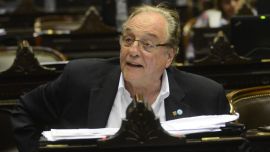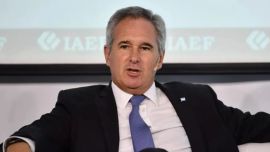In one of the most beloved episodes of the Simpsons’ 1990s golden age, Lisa grows disillusioned with the sexist Malibu Stacy doll and attempts to create her own, more grounded version. On the day of her doll’s big unveiling, however, she sees her efforts thwarted by a reboot that did nothing to change the flawed product at Malibu Stacy’s core.
“But, she has a new hat,” protests a frenzied crowd of shoppers, and Lisa is almost trampled in the rush to clear shelves. The first ‘Superliga’ season left a similar sensation as the campaign wound to an end; Argentine football may have received a makeover but the underlying issues have survived this inaugural year wholly untouched.
On the playing side at least little seems to have changed. Boca Juniors retained the title they lifted in 2016-17, after a season that owed more to the Xeneize’s admirable staying power than any signs of playing prowess. It was a strangely stunted term, in part forced by the necessity to continue trimming down the bloated Primera División that is the legacy of the late Julio Grondona’s 35-year dominance at the AFA.
Just 27 games were played by each team in nine months, making for a disjointed league that took on a different momentum after the summer break. Teams like Racing and River, who languished in 18th and 21st respectively at Christmas, were able to reinforce and claim spots in the top eight, while cash-strapped outfits such as Estudiantes and Colón dropped away alarmingly. That issue will not be properly solved until the AFA drops its attachment to a European August-May season and begins the new campaign in the summer months, even if that causes certain complications when it comes to negotiating transfers. In the meantime, with 26 teams in the top flight from next season scheduling could prove to be a real headache for those in charge, as the next format is still yet to be confirmed.
Off the field the new Superliga was more sorely felt on the television screens and in the pockets of fans. The now traditional steep hike in ticket costs was accompanied by the re-codification of the vast majority of matches, as TNT and Fox Sports marked their acquisition of broadcasting rights by eradicating the free-to-air football that had been the norm since 2009. Images not seen in Argentina for a decade arose once more: fans crowding outside the windows of bars for a glimpse of the action; sports channels keeping their cameras trained on the stands rather than players; the mass exodus of viewers from television to Internet streams of dubious legality. The inevitable consequence was a sharp drop in audience numbers. The Superclásico between River and Boca in November 2017 attracted 14 rating points, a respectable enough number until it is compared to the 32 points the show-piece fixture used to bring in on free-to-air channels.
Those lucky enough to tune in would also have seen wide swathes of empty stands in most fixtures. Five years after the death of a Lanús fan prior to a clash against Estudiantes ushered in a blanket ban on visiting fans that suspension is still no nearer to being lifted, despite countless promises from politicians of all colours to restore that beloved buzzword, “normality” to the game. A whole list of initiatives, from Fan Ids to online ticket sales, have been mooted, but while club presidents like Boca’s Daniel Angelici — “Neither the government nor the clubs have done anything to change the outlook,” he said in January when asked about the issue — oppose their return the chances of real advances still appear slim.
So little has really changed since those glossy introductions promised a new era for Argentine football. Most clubs continue to scrape by hand to mouth from month-to-month, while fans are yet to see any real improvements to go with the Superliga logo. The Primera might have a new hat, but its remake cannot hide the structural failings that continue to dog the sport at its highest level.






















Comments